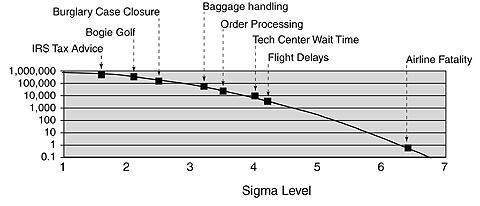Tools
Concepts
What does the term "Six Sigma" stand for
Black Belt Selection & Training
Applications
Does Six Sigma Work in Smaller Companies?
Six Sigma in Information Systems
Six Sigma in Staffing and Employee Relation
Six Sigma application to software projects
Importance of SPC to Six Sigma Projects
Integrating Six Sigma and Related Initiatives
Six Sigma vs. ISO 9001 and Baldrige
Difference between TQM & Six Sigma
Example Sigma Levels
10/13/2007
We are working to implement Six Sigma, and would like to use your diagram (shown in this figure) to better explain it to upper management. We just want to fully understand what the sigma levels represent.

Example Sigma Levels (from Six Sigma Demystified (2011, McGraw-Hill) by Paul Keller.
My specific questions are 1) is this actual data or illustrative? 2) what does the bogey golf number represent? 3) what about the airline fatality
(is that plane crashes, individual fatalities, etc.)
Judy C.
Consultant, Business Optimization
The IRS data is based on a hypothetical 40% error rate, but is in line with what has been reported by some surveys published in the press over the years. Most of the other
data points are based on data published on the web, such as by the NTSB and FBI.
The general technique to calculate sigma level is to determine the error rate, which can then be directly converted to a sigma level. When calculating
the error rate from a given sample, the denominator is the number of opportunities. In the IRS tax advice example, each question was considered an opportunity, and if the question was incorrectly answered then it was counted as an
error. So in this case, 40% of the questions were incorrectly answered. This will calculate Sigma Level of 1.75.
The NTSB numbers, if I remember correctly, were defined based on an opportunity being a passenger trip. In fact, that
is a good example of how reported Sigma Levels can be manipulated to achieve a particular agenda. I cover this more in my book, and in the training materials, but basically when the number of opportunities is inflated, then the error
rate goes down and the Sigma Level goes up. For the NTSB, you could consider a passenger mile as your opportunity, rather than a passenger trip. Since each trip is many miles, that inflates the number of opportunities, even if there is
no increased risk from a 2000 mile trip over a 200 mile trip. (Experts tend to say that the risks in air travel are dominated by takeoff and landing, rather than miles).
I was not able to find the original calculations I used to
come up with the bogie golf sigma level, but a reasonable approach is to assume that there are 72 opportunities in a golf game if one is to achieve par. Of these, 18 would be sufficiently errant to require an additional shot or a
penalty stroke, resulting in a error rate of 25% or a Sigma Level of about 2.2. Of course there are many ways to achieve bogie golf, so there is some presumed error in that estimate. Honestly, it was only included to add some levity to
the topic.
Earlier posts discussed how to convert a DPMO estimate to a Sigma Level using the Sigma Level calculation, and the difference between Three Sigma and Six Sigma.
Learn more about the Lean Six Sigma principles and tools for process excellence in Six Sigma Demystified (2011, McGraw-Hill) by Paul Keller, in his online Lean Six Sigma DMAIC short course ($249), or his online Green Belt certification course ($499).





